2007 CHEVROLET TRAIL BLAZER maintenance schedule
[x] Cancel search: maintenance schedulePage 2 of 574

Four-Wheel Drive
.................................. 440
Front Axle
............................................ 440
Bulb Replacement
................................ 442
Windshield Wiper Blade Replacement
.... 444
Tires
..................................................... 448
Appearance Care
.................................. 491
Vehicle Identi�cation
............................. 501
Electrical System
.................................. 502
Capacities and Speci�cations
................ 513Maintenance Schedule
.............................. 515
Maintenance Schedule
.......................... 516
Customer Assistance Information
............. 537
Customer Assistance and Information
..... 538
Reporting Safety Defects
...................... 552
Vehicle Data Recording and Privacy
..... 555
Index
.......................................................... 559
2
Page 215 of 574
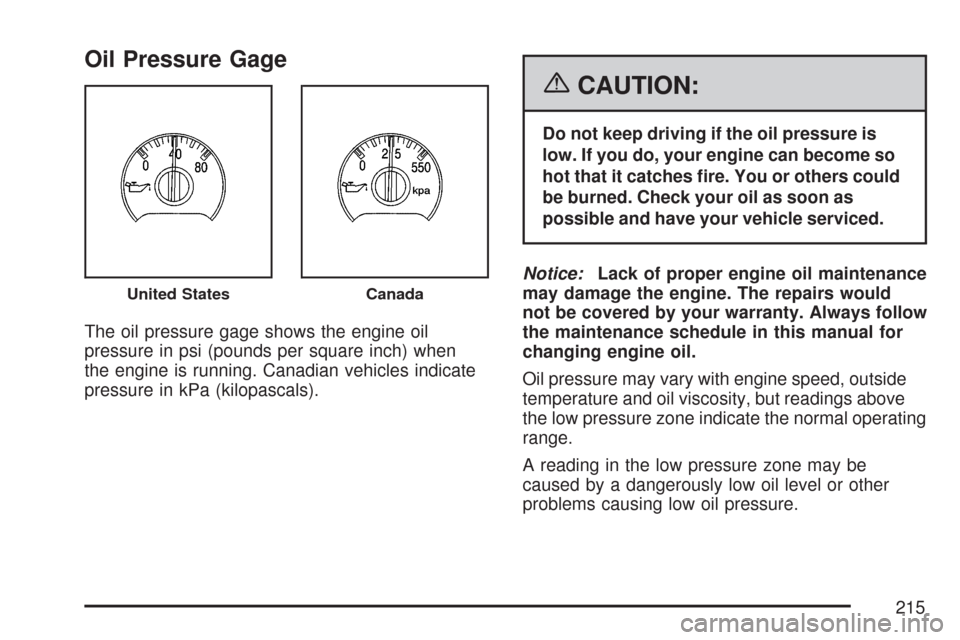
Oil Pressure Gage
The oil pressure gage shows the engine oil
pressure in psi (pounds per square inch) when
the engine is running. Canadian vehicles indicate
pressure in kPa (kilopascals).
{CAUTION:
Do not keep driving if the oil pressure is
low. If you do, your engine can become so
hot that it catches �re. You or others could
be burned. Check your oil as soon as
possible and have your vehicle serviced.
Notice:Lack of proper engine oil maintenance
may damage the engine. The repairs would
not be covered by your warranty. Always follow
the maintenance schedule in this manual for
changing engine oil.
Oil pressure may vary with engine speed, outside
temperature and oil viscosity, but readings above
the low pressure zone indicate the normal operating
range.
A reading in the low pressure zone may be
caused by a dangerously low oil level or other
problems causing low oil pressure.
United StatesCanada
215
Page 216 of 574

Change Engine Oil Light
Your vehicle may
have a change
engine oil light.
When this light comes on it means that an oil
change and other maintenance procedures
are required for your vehicle.
SeeScheduled Maintenance on page 519and
Engine Oil on page 402for more information.
Once the engine oil has been changed, the change
engine oil light must be reset. Until it is reset,
the light will stay on when the engine is on.
Security Light
This light will come on
brie�y when you turn
the key toward START.
The light will stay on until the engine starts.
If the light �ashes, the Passlock
®system has
entered a tamper mode. If the vehicle fails to
start, seePasslock
®on page 110.
If the light comes on continuously while driving
and stays on, there may be a problem with
the Passlock
®system. Your vehicle will not be
protected by Passlock®, and you should see
your dealer.
Also, seeContent Theft-Deterrent on page 108
for additional information regarding the security
light.
216
Page 223 of 574
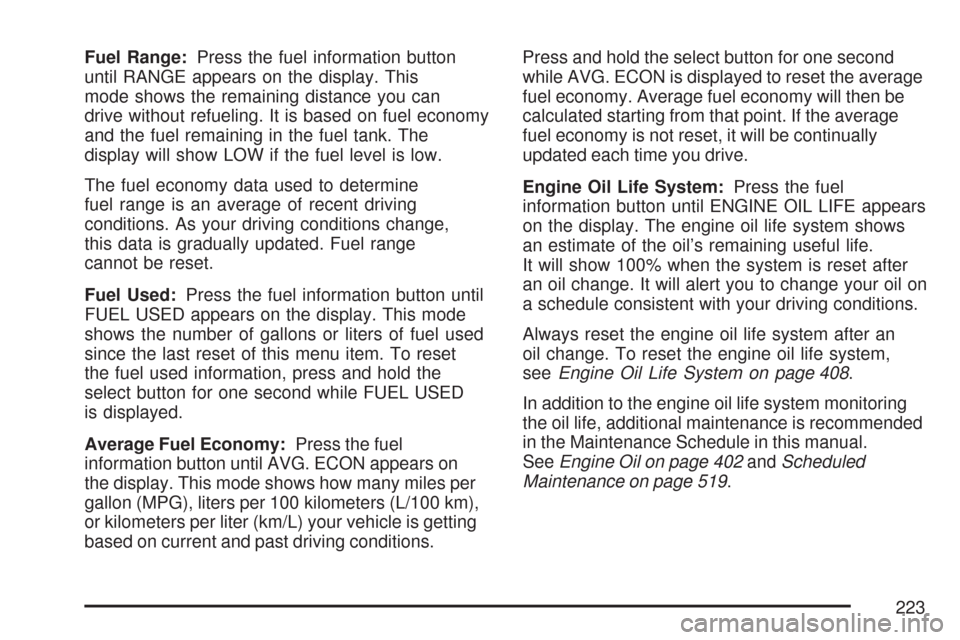
Fuel Range:Press the fuel information button
until RANGE appears on the display. This
mode shows the remaining distance you can
drive without refueling. It is based on fuel economy
and the fuel remaining in the fuel tank. The
display will show LOW if the fuel level is low.
The fuel economy data used to determine
fuel range is an average of recent driving
conditions. As your driving conditions change,
this data is gradually updated. Fuel range
cannot be reset.
Fuel Used:Press the fuel information button until
FUEL USED appears on the display. This mode
shows the number of gallons or liters of fuel used
since the last reset of this menu item. To reset
the fuel used information, press and hold the
select button for one second while FUEL USED
is displayed.
Average Fuel Economy:Press the fuel
information button until AVG. ECON appears on
the display. This mode shows how many miles per
gallon (MPG), liters per 100 kilometers (L/100 km),
or kilometers per liter (km/L) your vehicle is getting
based on current and past driving conditions.Press and hold the select button for one second
while AVG. ECON is displayed to reset the average
fuel economy. Average fuel economy will then be
calculated starting from that point. If the average
fuel economy is not reset, it will be continually
updated each time you drive.
Engine Oil Life System:Press the fuel
information button until ENGINE OIL LIFE appears
on the display. The engine oil life system shows
an estimate of the oil’s remaining useful life.
It will show 100% when the system is reset after
an oil change. It will alert you to change your oil on
a schedule consistent with your driving conditions.
Always reset the engine oil life system after an
oil change. To reset the engine oil life system,
seeEngine Oil Life System on page 408.
In addition to the engine oil life system monitoring
the oil life, additional maintenance is recommended
in the Maintenance Schedule in this manual.
SeeEngine Oil on page 402andScheduled
Maintenance on page 519.
223
Page 225 of 574
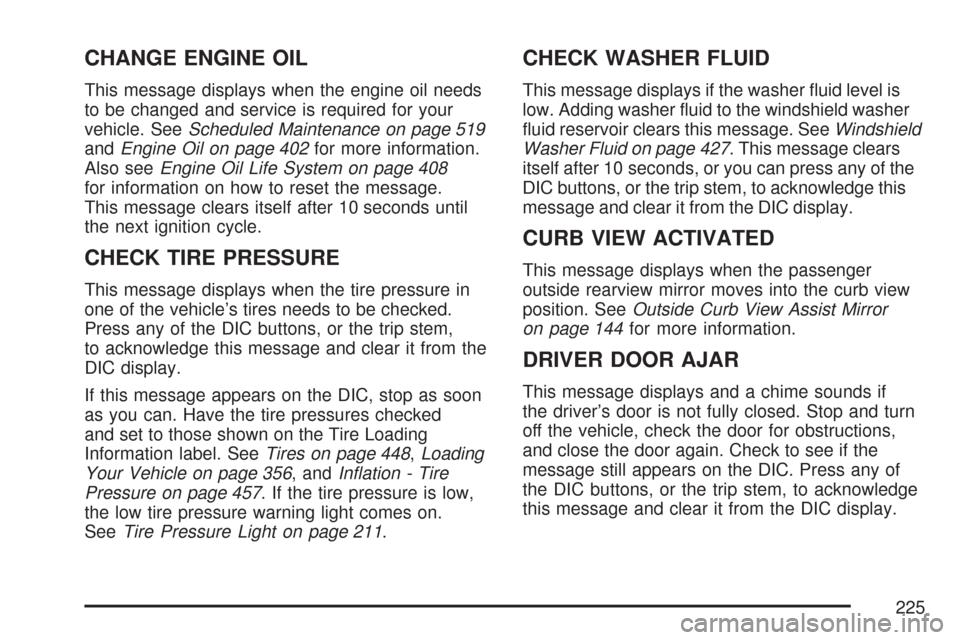
CHANGE ENGINE OIL
This message displays when the engine oil needs
to be changed and service is required for your
vehicle. SeeScheduled Maintenance on page 519
andEngine Oil on page 402for more information.
Also seeEngine Oil Life System on page 408
for information on how to reset the message.
This message clears itself after 10 seconds until
the next ignition cycle.
CHECK TIRE PRESSURE
This message displays when the tire pressure in
one of the vehicle’s tires needs to be checked.
Press any of the DIC buttons, or the trip stem,
to acknowledge this message and clear it from the
DIC display.
If this message appears on the DIC, stop as soon
as you can. Have the tire pressures checked
and set to those shown on the Tire Loading
Information label. SeeTires on page 448,Loading
Your Vehicle on page 356, andIn�ation - Tire
Pressure on page 457. If the tire pressure is low,
the low tire pressure warning light comes on.
SeeTire Pressure Light on page 211.
CHECK WASHER FLUID
This message displays if the washer �uid level is
low. Adding washer �uid to the windshield washer
�uid reservoir clears this message. SeeWindshield
Washer Fluid on page 427. This message clears
itself after 10 seconds, or you can press any of the
DIC buttons, or the trip stem, to acknowledge this
message and clear it from the DIC display.
CURB VIEW ACTIVATED
This message displays when the passenger
outside rearview mirror moves into the curb view
position. SeeOutside Curb View Assist Mirror
on page 144for more information.
DRIVER DOOR AJAR
This message displays and a chime sounds if
the driver’s door is not fully closed. Stop and turn
off the vehicle, check the door for obstructions,
and close the door again. Check to see if the
message still appears on the DIC. Press any of
the DIC buttons, or the trip stem, to acknowledge
this message and clear it from the DIC display.
225
Page 338 of 574
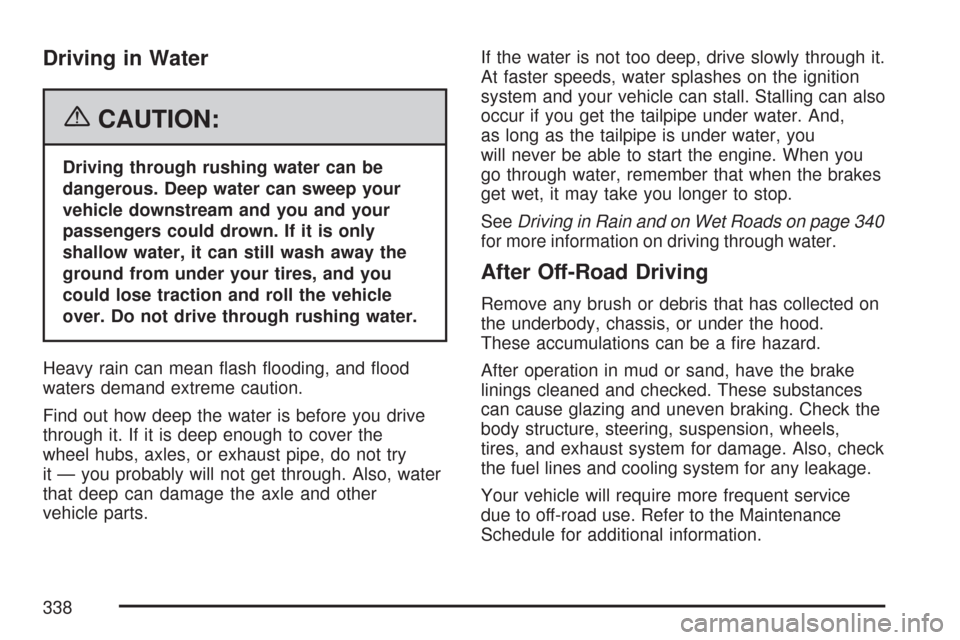
Driving in Water
{CAUTION:
Driving through rushing water can be
dangerous. Deep water can sweep your
vehicle downstream and you and your
passengers could drown. If it is only
shallow water, it can still wash away the
ground from under your tires, and you
could lose traction and roll the vehicle
over. Do not drive through rushing water.
Heavy rain can mean �ash �ooding, and �ood
waters demand extreme caution.
Find out how deep the water is before you drive
through it. If it is deep enough to cover the
wheel hubs, axles, or exhaust pipe, do not try
it — you probably will not get through. Also, water
that deep can damage the axle and other
vehicle parts.If the water is not too deep, drive slowly through it.
At faster speeds, water splashes on the ignition
system and your vehicle can stall. Stalling can also
occur if you get the tailpipe under water. And,
as long as the tailpipe is under water, you
will never be able to start the engine. When you
go through water, remember that when the brakes
get wet, it may take you longer to stop.
SeeDriving in Rain and on Wet Roads on page 340
for more information on driving through water.
After Off-Road Driving
Remove any brush or debris that has collected on
the underbody, chassis, or under the hood.
These accumulations can be a �re hazard.
After operation in mud or sand, have the brake
linings cleaned and checked. These substances
can cause glazing and uneven braking. Check the
body structure, steering, suspension, wheels,
tires, and exhaust system for damage. Also, check
the fuel lines and cooling system for any leakage.
Your vehicle will require more frequent service
due to off-road use. Refer to the Maintenance
Schedule for additional information.
338
Page 380 of 574
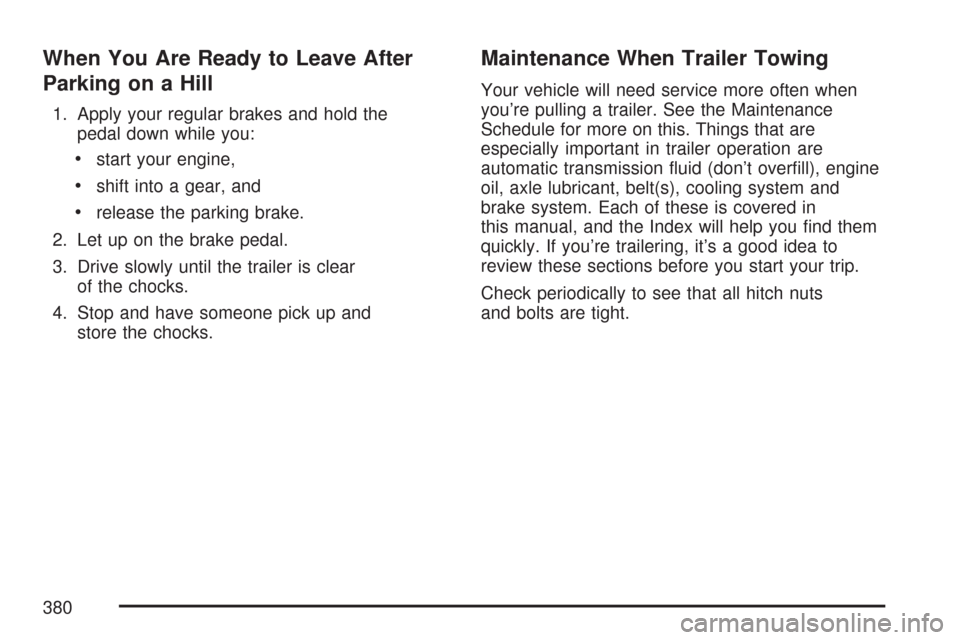
When You Are Ready to Leave After
Parking on a Hill
1. Apply your regular brakes and hold the
pedal down while you:
start your engine,
shift into a gear, and
release the parking brake.
2. Let up on the brake pedal.
3. Drive slowly until the trailer is clear
of the chocks.
4. Stop and have someone pick up and
store the chocks.
Maintenance When Trailer Towing
Your vehicle will need service more often when
you’re pulling a trailer. See the Maintenance
Schedule for more on this. Things that are
especially important in trailer operation are
automatic transmission �uid (don’t over�ll), engine
oil, axle lubricant, belt(s), cooling system and
brake system. Each of these is covered in
this manual, and the Index will help you �nd them
quickly. If you’re trailering, it’s a good idea to
review these sections before you start your trip.
Check periodically to see that all hitch nuts
and bolts are tight.
380
Page 410 of 574

Engine Air Cleaner/Filter
SeeEngine
Compartment Overview
on page 396for the
location of the engine air
cleaner/�lter.
When to Inspect the Engine
Air Cleaner/Filter
Inspect the air cleaner/�lter at the MaintenanceII
intervals and replace at the �rst oil change
after each 50,000 mile (83 000 km) interval.
SeeScheduled Maintenance on page 519
for more information. If you are driving in
dusty/dirty conditions, inspect the �lter at each
engine oil change.
How to Inspect the Engine
Air Cleaner/Filter
To inspect the air cleaner/�lter remove the �lter
from the vehicle and lightly shake the �lter to
release loose dust and dirt. If the �lter remains
caked with dirt, a new �lter is required.
To inspect or replace the engine air cleaner/�lter,
do the following:
1. Remove the screws on the engine air
cleaner/�lter and lift off the cover.
2. Remove the air cleaner/�lter from the housing.
Care should be taken to dislodge as little dirt
as possible.
3. Inspect or replace the engine air cleaner/�lter.
4. Reinstall the cover and tighten the screws.
4.2L L6 Engine shown,
5.3L and 6.0L V8
Engines similar
410